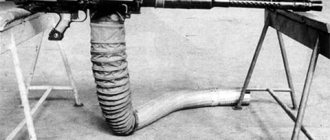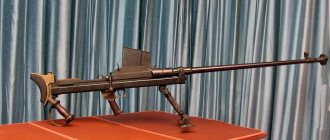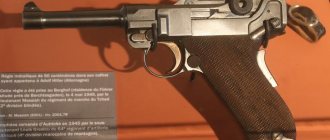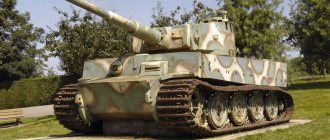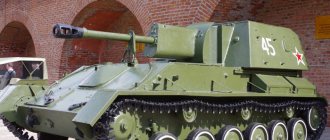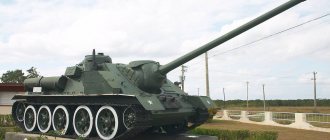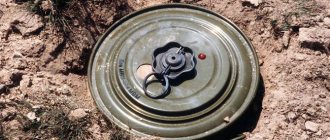Home » Real story » History of Wars » Yuri Pasholok. Marder II: light fighter
History of WarBooks on the history of tanks
boroda 04/18/2019 1223
12
in Favoritesin Favoritesfrom Favorites 8
The German military began to understand that the time of light tanks was passing at the end of 1941. This fully applied to the Pz.Kpfw.II tank. By that time, its main opponents were medium tanks with shell-resistant armor, against which the 20-mm automatic cannon was practically useless. In the summer of 1942, the production of light tanks in Germany ceased, but this by no means meant the death of the Pz.Kpfw.II chassis. Back in the spring, work began on creating light self-propelled artillery units based on this tank. One of them was a tank destroyer, best known as the Marder II.
German fighter at a Czechoslovak base
The Great Patriotic War, which began on June 22, 1941, made serious adjustments not only to Soviet, but also to German tank building.
The battles of the summer-winter of 1941 showed that the time of light tanks was running out. At the same time, the increase in the combat weight of increasingly powerful anti-tank guns significantly limited the possibility of their movement across the battlefield by crews. The chassis capabilities of the German light tank Pz.Kpfw.I Ausf.B turned out to be limited; nothing more powerful than the Panzerjäger I could be created on its basis. It is not surprising that the German command had the idea to create self-propelled anti-tank artillery based on other outdated light tanks. In this material we will talk about tank destroyers of the Marder III , which were built on the basis of the Pz.Kpfw.38(t) .
The path of least resistance
The situation with the Pz.Kpfw.38(t) in 1941 can be called critical. The fact is that this tank in the German army was classified as a light tank conditionally. In practice, vehicles of this type played a role similar to that of the Pz.Kpfw.III medium tank. It is not surprising that the losses among them in 1941 were record-breaking: on June 22, 1941, the troops had 772 tanks, and by the end of the year 796 were lost. No other tank of the German army could boast of such heavy losses. It became clear that the Pz.Kpfw.38(t)'s career was coming to an end.
At the same time, there were no special questions from the German military about the chassis of this tank. Of all the light tanks produced in Germany and in the territories it occupied, it was the products of the Czech plant BMM (before the occupation - ČKD) that looked the most promising. The dimensions of the chassis, as well as the capabilities of the Pz.Kpfw.38(t) chassis, made it relatively easy to convert the vehicle into a self-propelled unit.
Pz.Slf.2 1st series, BMM, spring 1942. Noteworthy is the mounting of the gun in a traveling manner, which quite often failed
The decision to develop a tank destroyer using the Pz.Kpfw.38(t) chassis was made on December 22, 1941. In 6 (Inspekteur für Heeresmotorisierung, Inspectorate of Motorized Troops) issued the task to the 6th Department of the Armaments Department just 2 days after the launch of a similar program using the La.S.138 chassis (Pz.Kpfw.II Ausf.D and Ausf.E). Similar to the 7.62 cm Pak 36(R) auf Fgst self-propelled gun. Pz.Kpfw.II(F) (Sfl.), the tactical and technical requirements looked very difficult. Since self-propelled artillery was needed in the shortest possible time, those at the top considered it necessary to minimize modifications to the chassis. The specification for the chassis went to BMM, which was tasked with producing a prototype chassis.
The same car behind. The design of the fighting compartment made it possible to put additional shell boxes at the rear
The conversion of the gun part was entrusted to the Rheimetall-Borsig concern, which was just at that moment working on the 7.62 cm Pak 36(R) auf Fgst. Pz.Kpfw.II(F) (Sfl.). It should not be surprising that the installation for the new self-propelled guns turned out to be very similar. The swinging part of the 76-mm Pak 36(t) anti-tank gun, which was converted into captured Soviet F-22 guns, was taken as the basis. In addition to the new ammunition, the Pak 36(R) was distinguished by the redesign of the aiming mechanisms, the installation of a telescopic sight and the appearance of a muzzle brake. To protect the crew, the gun mount received shield cover. It protected the crew not only from the front, but also partially from the sides. The design of the shield cover almost completely repeated the protection of the installation for the 7.62 cm Pak 36(R) auf Fgst. Pz.Kpfw.II(F) (Sfl.), with the difference that the sheets were assembled using riveted joints. This turned out to be due to the fact that welding for assembling armored vehicles on the BMM had not yet been mastered.
The vehicle of the second production series is easily identified by the new mounting of the gun in a traveling manner
The BMM designers had to work hard with the chassis for the new self-propelled gun. As required by the technical specifications, the design of the chassis, designated Pz.Sfl.2, did not change. Even the turret box (with the exception of the roof) was preserved. The designers faced the same problems as in the case of the conversion of the La.S.138 (Pz.Kpfw.II). The layout with a central shaft running from the engine to the gearbox complicated the task. The designers had to make a massive base in the shape of a cross, which was attached to the front plate and the sides of the turret box. The swinging part of the gun was mounted on this same crosspiece. In addition to the turret box plates, additional armor plates were installed in the frontal area, as well as along the sides. Like the tank destroyer based on the La.S.138, the fighting compartment was partially located on the engine plate.
This photo clearly shows how the awning was attached
It is difficult to call such a layout solution ideal, since the total height has increased to 2.5 meters. However, the BMM completed the task more successfully than in the case of the 7.62 cm Pak 36 (R) auf Fgst. Pz.Kpfw.II(F) (Sfl.). For starters, access to the engine was less problematic. At the same time, however, dismantling the gearbox still looked like a non-trivial task. The solution with the placement of a driver and a gunner-radio operator turned out to be more competent. Here they had their own hatches, and to get to their places they did not need to make their way through the fighting compartment. The space under the gun was used more rationally: the ammunition load, amounting to 30 rounds, was located in close proximity to the gunner and loader. The combat weight of the vehicle was 10.8 tons, that is, almost a ton less than a similar vehicle based on the La.S.138. Finally, the line of fire here was located 20 centimeters lower, which had a positive effect on stability when shooting.
Pz.Sfl.2 für 7.62 cm Pak 36 third production series
On March 6, 1942, contract No. 219/326/42H was signed with BMM for the production of 120 Pz.Slf.2 1st series. The production rate was set as follows: 24 vehicles were expected by March 24, another 16 by March 31, 70 by April 28, and 17 by May 5. At the same time, the contract with the plant for the production of 500 Pz.Kpfw.38(t) continued to be valid. . Despite this, BMM was able to complete most of the March task - during this month they managed to deliver 33 Pz.Sfl.2s. The problem was that while ready-made chassis were available, the delivery of gun mounts for them was delayed. The implementation of plans seriously sagged in April - instead of 70 cars, 35 were delivered.
By the way, self-propelled units, including vehicles produced in March, were officially accepted from the manufacturer in April. At the same time, for the first time, the index 7.62 cm Pak 36(R) auf Fgst was used in relation to them. Pz.Kpfw.38(t) (Sfl), that is, “76-mm Pak 36 (R) gun on a Pz.Kpfw.38(t) self-propelled chassis.” The remaining 52 self-propelled guns were delivered in May 1942, some of them were produced in tropical configuration. According to the good German tradition, the designation of the car was changed several times. In 1942 alone, 5 designations were used. The name Pz.Sfl.2 für 7.62 cm Pak 36, first dated July 1942, should be considered more or less established. At the same time, the car received the end-to-end index Sd.Kfz.132.
Self-propelled gun Pz.Sfl.2 für 7.62 cm Pak 36, converted from a repair tank Pz.Kpfw.38(t)
The production did not stop there. On May 7, 1942, at a meeting, Hitler stated that the Pz.Kpfw.38(t) was obsolete. Now, instead of these vehicles, tank destroyers should be produced at the same base. At a meeting on May 13, it was decided to produce at least 20 Pz.Sfl.2 für 7.62 cm Pak 36 every month. And the final decision on the future of the Pz.Kpfw.38(t) tank was made on June 4: on this day the order was approved 2 series of tank destroyers, and conventional tanks were withdrawn from production, while their chassis were used to produce self-propelled guns.
In June, 26 Pz.Kpfw.38(t) and 23 Pz.Sfl.2 für 7.62 cm Pak 36 were delivered. The vehicles of the second series were somewhat different: due to minor alterations, it was possible to increase the gun declination angle by 2 degrees. The gun mounting stop was also modified in a traveling manner. All self-propelled guns produced in June were produced in a tropical configuration. Another 50 Pz.Sfl.2 für 7.62 cm Pak 36 were manufactured in July, the remaining 27 in August.
Captured tank destroyer at the NIBT Test Site, summer 1943
Starting in August 1942, production of the Pz.Sfl.2 für 7.62 cm Pak 36 of the third series began. Externally, these self-propelled guns differed slightly in the design of the control compartment hatches. In addition, some of the vehicles received more powerful Praga AC engines. Thanks to the 150-horsepower engine, the maximum speed increased to 47 km/h. A total of 344 Pz.Sfl.2 für 7.62 cm Pak 36 were produced in three series, with chassis numbers ranging from 1360–1479 and 1527–1750. The production of self-propelled guns of this type did not end there: starting in February 1943, Pz.Kpfw.38(t) that arrived from the front were converted into them. We can talk about about three dozen such converted cars.
The Pz.Sfl.2 für 7.62 cm Pak 36 began to enter service in May 1942. Unlike self-propelled guns based on the Pz.Kpfw.II, these vehicles were sent not to tank destroyer battalions, but to tank divisions. An exception was made for the 521st tank destroyer battalion, where 12 vehicles were sent on May 27, 1942. Typically, a battery of 6 self-propelled guns was sent to tank divisions. At the same time, there were cases when 9 (18th TD) and 12 (8th and 19th TD) pieces were sent. Some of the first recipients were the 15th and 21st Panzer Divisions, which fought in North Africa. Later, another 39 tank destroyers of this type were sent to North Africa. The tendency to equip tank divisions with Pz.Sfl.2 für 7.62 cm Pak 36s continued further.
The same car on the left
Self-propelled guns of this type went into battle for the first time in July 1942. Reviews about the car turned out to be somewhat similar to those received regarding the 7.62 cm Pak 36(R) auf Fgst. Pz.Kpfw.II(F) (Sfl.). First of all, this concerns the weapon, more precisely, the height of its location. The excessive height made the vehicle an easy target, and the bulletproof armor did not always help. The placement of ammunition also caused a lot of criticism. The fact is that at maximum horizontal aiming angles, the laying was blocked by the gun and the shield cover. A lot of negative feedback was also received regarding the travel gun stopper.
At the same time, the weapon itself received praise. From 350 meters, an armor-piercing projectile confidently penetrated the frontal armor of the KV-1, and this was by no means the maximum distance. The negative side of the gun was unanimously pointed out as the muzzle brake, which raised a cloud of dust when firing.
A significant difference in reviews regarding the 7.62 cm Pak 36 (R) auf Fgst. Pz.Kpfw.II(F) (Sfl.) and Pz.Sfl.2 für 7.62 cm Pak 36 was that there were few complaints about the reliability of the chassis of the second self-propelled gun. Complaints were received about weak spring fastenings, transmission elements occasionally failed, and sometimes there were reviews about insufficient traction. At the same time, high vehicle mobility, good suspension performance and low noise levels were noted. Major problems with the chassis were noted only in North Africa. Despite the fact that self-propelled guns have undergone certain modifications to work in hot climates, they turned out to be not very adapted to it. The engines suffered the most, as they often failed.
The photo from the rear clearly shows the fighting compartment.
The ambiguous, to put it mildly, ending of the 1942 campaign directly affected the number of Pz.Sfl.2 für 7.62 cm Pak 36. By June 30, 1943, 94 vehicles of this type remained in the Wehrmacht, of which 8 were under repair. From July 1943, they were renamed Panzerjäger 38 7.62 cm Pak 36, changing the end-to-end designation to Sd.Kfz.139. By the end of the year, only 38 vehicles remained, which by that time began to be called Marder III. It is worth noting that this designation was rarely used.
These vehicles fought until the end of the war: as of January 22, 1945, the troops still had 23 self-propelled guns. Two of them have survived to this day: one is located in Fort Lee (USA), and the second is in France, in the tank museum of the city of Saumur.
Transition to Pak 40
The use of the 7.62 cm Pak 36 ® as the main weapon for anti-tank self-propelled guns was rather a half-measure. The main problem with this gun was that the number of such guns turned out to be limited. Production of the F-22 ceased even before the war, and no new significant “receipts” of trophies could be counted on. The German leadership understood this very well, so back in early March 1942 the question of alternative armament for tank destroyers based on the Pz.Kpfw.38(t) was raised.
Self-propelled gun 7.5 cm Stu.Kan. auf Pz.Kpfw.38(t). Work on it did not progress beyond the production of a prototype.
Oddly enough, the first proposed alternative was not an anti-tank gun. On March 8, 1942, Hitler proposed installing a 75-mm StuK 40 L/43 gun on the Pz.Kpfw.38(t) chassis. Just at this moment, preparations were underway for the launch of the StuG 40 Ausf.F self-propelled gun, armed with the same weapon. The idea looked quite sensible, since the StuK 40 featured more compact recoil devices. This is how the 7.5 cm Stu.Kan self-propelled gun was born. auf Pz.Kpfw.38(t). The chassis for it was developed at BMM, and the gun mount was developed by the German company Alkett. Unlike the Pz.Sfl.2 für 7.62 cm Pak 36, the vehicle received a developed shield cover, which more effectively protected the crew. The vehicle was also distinguished by the fact that it retained the standard control compartment hatches. However, mass production of 7.5 cm Stu.Kan. auf Pz.Kpfw.38(t) was never established. It turned out to be easier to install a 75-mm Pak 40 anti-tank gun on the tracks, which, moreover, was a little more powerful.
Prototype Sfl.38, June 1942
On May 7, 1942, at the same meeting where Hitler doubted the advisability of further production of the Pz.Kpfw.38(t), he also raised the question of creating vehicles based on the tank with weapons in the form of 7.5 cm Pak 40. Calculations showed that there would be no problems with the installation of this weapon will not arise. By the end of June, a prototype of a self-propelled gun, designated 7.5 cm Pak 40 auf Pz.Kpfw.38(t), was successfully tested at the Milovice training ground.
Serial 7.5 cm Pak 40 auf Pz.Kpfw.38(t). The photo shows how the awning was attached
The concept of the chassis, also designated Sfl.38, was noticeably different from the previous installation. On the one hand, it also took into account the requirements for a minimal change in the Pz.Kpfw.38(t) base. The turret box was also preserved here, with the exception of the roof. On the other hand, the fighting compartment turned out to be completely different. Instead of a movable shield cover, a rather massive wheelhouse appeared, open at the back, and also partially at the sides and at the top. This design protected the crew from small arms fire much more effectively. The crosspiece that served as the basis for the rolling part of the Pak 40 has been preserved, but at the same time it has become less massive. The number of cartridges for the gun increased to 38 pieces. In addition, additional boxes could be placed on a platform formed above the engine compartment. This platform was designed in such a way that it did not interfere with engine maintenance.
Instead of large seats, the commander/gunner and loader received small perch seats. In addition, the new vehicle has no hatches for the driver and radio operator. The rational layout led to the fact that the combat mass remained at the old level. The height of the vehicle remained at the same level (2.5 meters), but the height of the firing line decreased to 1.96 meters.
From a layout point of view, the vehicle turned out to be more rational than the Pz.Sfl.2 für 7.62 cm Pak 36
The German leadership was pleased with the new self-propelled gun. It was assumed that the first 24 vehicles would be delivered in August 1942, but the deadlines had to be shifted. The fact is that at this time the production of the Pz.Sfl.2 für 7.62 cm Pak 36 of the third series began. As a result, the start of production was moved to November 1942. The delay was beneficial for the car, since from the very beginning they began installing more powerful Praga AC engines on it. It was assumed that in the first month it would be possible to produce 50 7.5 cm Pak 40 auf Pz.Kpfw.38(t), but in reality the number of vehicles received was 42 pieces. They managed to catch up in December, when 68 cars left BMM.
One of the self-propelled units that were made by converting repair Pz.Kpfw.38(t)
The life of the 7.5 cm Pak 40 auf Pz.Kpfw.38(t) turned out to be short: the last 6 self-propelled guns of this type left the BMM in May 1943. In total, 275 vehicles of this type were manufactured with chassis numbers 1751–2075 and 2121–2147. Also, in May 1943, the conversion of repair Pz.Kpfw.38(t) into similar vehicles began. In total, 175 tanks were converted in this way.
Captured 7.5 cm Pak 40/3 auf Sfl.38 (Ausf.H). NIBT Test Site, summer 1943
The troops began to receive self-propelled guns in January 1943. The supply was uneven; often the vehicles were sent as replenishment. At first, priority was given to tank units, but by the spring of 1943 the situation had changed somewhat. Losses of materiel led to the fact that self-propelled guns, designated as 7.5 cm Pak 40/3 auf Sfl.38 (Ausf.H) from May 1943, began to arrive in separate tank destroyer battalions (559, 616, 731, 742, 743 and 744). The number of vehicles received turned out to be uneven: the 731st battalion received the most, which received 36 units, the rest received from 13 to 19 vehicles. They also appeared in fighter battalions as part of infantry divisions.
The same car on the left. It is clearly visible that the crew was reliably covered on the sides from bullets and shrapnel
Feedback from the troops regarding the self-propelled gun turned out to be very similar to the Pz.Sfl.2 für 7.62 cm Pak 36. They were greatly influenced by the fact that the 7.5 cm Pak 40/3 auf Sfl.38 (Ausf.H) went into battle February 1943, when the Wehrmacht was going through hard times. By this time, the Germans had switched from offensive to defensive; until March 1943, the initiative was on the side of the Red Army. In addition, the StuG 40 Ausf.G self-propelled guns began to arrive in large numbers. In March 1943 alone, 197 StuG 40 Ausf.G were produced, and in May - already 260. Of course, the 7.5 cm Pak 40/3 auf Sfl.38 (Ausf.H) was much better than the towed Pak 40, but at the same time the vehicle had tall silhouette and was not distinguished by thick armor. Against this background, the StuG 40, with frontal armor reaching a thickness of 80 mm and also having a lower profile, looked much more advantageous.
The same car in front. The unit's emblem is clearly visible
By June 30, 1943, there were 173 7.5 cm Pak 40/3 auf Sfl.38 (Ausf.H) in service, of which 10 were under repair. These vehicles took a direct part in Operation Citadel, which greatly affected their numbers. It is difficult to say exactly how many vehicles of this type survived by the end of 1943, since at that time they were considered together with later self-propelled units. During its service, the self-propelled gun was renamed 7 times. Its latest designations were the name 7.5 cm Pak 40/3 Sfl. Marder 38T and end-to-end index Sd.Kfz.138. Two such self-propelled units have survived to this day: one is located in the German Sinsheim, the second in the Italian Trieste.
Lightly Armored Optimum
The successful experience of converting the Pz.Kpfw.II Ausf.F chassis into the leFH 18/2 (Sf) auf GW II self-propelled gun gave rise to the idea of doing something similar with the Pz.Kpfw.38(t) chassis. In February 1943, BMM received the task of developing the Motor vorn chassis. The chassis layout turned out to be very similar to the GW II layout. The designers moved the engine and cooling system forward, and the control compartment was greatly reduced. The gunner-radio operator was removed, and the driver-mechanic received a separate cabin. Moving the engine compartment forward made it possible to organize a quite spacious fighting compartment in the stern, which accommodated three people - the commander, gunner and loader.
7.5 cm Pak 43/3 auf Sfl.38 (Ausf.M) Motor vorn of the very first releases. This car can be identified by its developed rear mudguards, which were quickly abandoned
The installation of weapons turned out to be very similar. The swinging part of the Pak 40/3 was placed on a base, which was located above the engine compartment. This decision allowed us to win a seat, but at the same time brought a lot of problems. In order to get to the engine if necessary, it was necessary to first remove the front side sheets of the cabin, then the gun mount, and then its base. Such problems, however, could be easily tolerated, since the benefits from the reconfiguration turned out to be much greater. Also, the thickness of the armor was noticeably reduced to compensate for the increase in mass. The combat weight still increased, but not by much - up to 11 tons.
This is what the main series cars of 1943 looked like
The resulting chassis was clearly right at home. On the basis of the Pz.Kpfw.38(t), the Germans finally managed to make a tank destroyer, in which the commander was responsible for his direct duties. In addition, a much more successfully designed fighting compartment made it possible to solve the problem of access to ammunition. It is not surprising that already in May 1943, production of a self-propelled unit began, designated 7.5 cm Pak 43/3 auf Sfl.38 (Ausf.M) Motor vorn. In the first month of production, 20 vehicles were delivered, in June 45, and in July 90. This made it possible to abandon the production of tank destroyers based on the Pz.Kpfw.II, concentrating the factories' efforts on the production of the more popular leFH 18/2 (Sf) auf GW II .
By the end of summer, the designation of the vehicle was changed to Panzerjäger 38, and the end-to-end designation Sd.Kfz.138 also appeared. As for the Marder III index, which is widespread in modern literature, it was first used in November 1943. It is worth noting that in reality there was no division into Marder III Ausf.H and Marder III Ausf.M. Such indexes simply did not exist.
The same car in front. The serial number of the car is visible on the front plate, which indicates that it was assembled in May 1943
Already during the production process, various changes began to be made to the design of the machine. To begin with, from July 1943, a more powerful Praga Ausf.IV engine with a capacity of 180 horsepower began to be installed. During operation, it turned out that it has far from outstanding reliability. The solution to the problem was its replacement in November 1943 with a 160-horsepower Praga Typ NS engine. It turned out to be less powerful, but more reliable. Also, from the summer of 1943, a command version went into production, which was equipped with additional radio equipment. In this regard, the ammunition capacity of the command vehicle was reduced to 26 rounds.
The most serious design change for the Panzerjäger 38 occurred in November 1943. By this time, BMM had finally mastered welding, so the driver's cabin and hull became welded. The crew compartment continued to be assembled using rivets.
Thanks to the rearrangement, it was possible to create a normal fighting compartment for three people
The Panzerjäger 38 became the second most popular German light tank destroyer. In 1943, 634 vehicles of this type were produced. Potentially, BMM could have produced more, but from the end of 1943 the same chassis began to be used for the construction of other self-propelled units. Not surprisingly, the rate of release began to decline steadily. Peak production of the Panzerjäger 38 was reached in October 1943, when 141 vehicles left BMM. Already in December, the production rate dropped to 75 cars, remaining within 60–70 cars until the end of production. The last 46 self-propelled guns were manufactured in May 1944, when BMM began producing Jagdpanzer 38(t) tank destroyers.
Unlike previous vehicles, Panzerjäger 38 began to be supplied primarily to equip infantry divisions. This was partly due to the fact that the tank divisions were already equipped with similar vehicles. These self-propelled guns were first delivered directly to tank divisions in September 1943. Supplies to the troops were uneven, including because the vehicles were sent to units as replacements.
The awning was attached to the Panzerjäger 38 in a similar way.
At the front, self-propelled guns of a new type appeared closer to the autumn of 1943. In terms of characteristics, they differed little from previous tank destroyers based on the Pz.Kpfw.38(t), so the reviews turned out to be similar. There were a lot of complaints about the driver's position. Visibility from it left much to be desired, and in cloudy weather water got inside through the cracks. The dense layout of the self-propelled guns has caused complaints about difficulties with maintenance.
Beginning in November 1943, log cabins began to be welded
Another problem turned out to be related to the incorrect use of self-propelled guns. You can often hear that in the Red Army self-propelled guns were often used as tanks. The truth is that the German infantry often used the self-propelled guns assigned to it in a similar way. Taking into account the high altitude and weak bulletproof armor of the Marder III, the results of such use are not difficult to predict. However, even by the end of the war, there were many vehicles of this family in the Wehrmacht. As of December 30, 1944, there were 227 of them in service, plus 62 were under repair. On March 15, 1945, 118 were in service, and another 51 were under repair. Of this number 4 Panzerjäger 38 have survived to this day.
The chassis began to be assembled using welding
It is worth recognizing that the very concept of a light “self-propelled gun carriage” turned out to be quite reasonable. At the same time, it is somewhat reckless to say that German and Czech designers were able to obtain the optimal design. The desire to preserve the tank's base as much as possible without major changes led to the fact that even the redesigned Pz.Kpfw.38(t) chassis was not without its shortcomings.
The SU-76M, the closest Soviet analogue to the Panzerjäger 38, turned out to be much more successful. This vehicle also made maximum use of the components of a light tank, but the chassis itself was developed almost from scratch and taking into account the requirements for the self-propelled gun itself. Soviet designers managed to produce a vehicle that was slightly inferior to the Panzerjäger 38 in terms of weapon power and maximum speed, but was superior in other respects. The SU-76M turned out to be lower and more stable when firing, its fighting compartment was larger, and visibility from the driver’s seat was better. In addition, the Soviet car was much easier to maintain.
Sources and literature:
- Materials from TsAMO RF
- ČKD archive materials
- Panzer Tracts No. 7–2 — Panzerjaeger (7.62 cm FK® auf gp.Sfl. to Marder 38T) development and employment from 1941 to 1943, Thomas L. Jentz, Hilary Louis Doyle, Darlington Publication, 2005, ISBN 0–9744862–9–9
- Nuts & Bolts Vol.15 - "Marder III". Panzerjäger 38 (t) für 7.62 cm Pak 38 (Sd.Kfz. 139), Volker Andorfer, Martin Block, John Nelson, Nuts & Bolts, 2001
- Nuts & Bolts Vol.18: “Marder III” Panzerjäger 38(t) für 7.5 cm Pak 40/3, Sd.Kfz. 138, Part 2: Ausführung H & 7,5cm Pak 40 towed version, Volker Andorfer, Martin Block, John Nelson, Nuts & Bolts, 2004
- Nuts & Bolts Vol.17: “Marder III” Panzerjäger 38(t) für 7.5 cm Pak 40/3, Sd.Kfz. 138, Part 1: Ausf.M, Volker Andorfer, Martin Block, John Nelson, Nuts & Bolts, 2003
gun
If in general characteristics we were faced with several very weak points, then from the point of view of weapons, this device is very good, in fact, we can only hope for a cannon in battle.
Let's start with the fact that the Marder 38T has a gun
It has a solid alpha strike by the standards of level 4 technology and a good rate of fire, which allows us to knock out approximately 2060 pure level units per minute from enemies.
There are no big problems with penetration either; you will only use gold supplies in battles against the sixth levels. Otherwise, the Marder 38T tank
easily penetrates all classmates and A's, the latter just need to be targeted.
Regarding the last remark - there should be no problems in targeting vulnerable areas in the enemy’s armor, because Marder 38T WoT
boasts excellent accuracy. The dispersion of our gun is very compact, it converges quickly, and therefore poor stabilization will never be a hindrance.
Moreover, if we talk about the vertical and horizontal aiming angles, everything is just perfect. Down your barrel German tank Marder 38T
can lower it by 9 degrees, and the UGNs total as much as 56 degrees, that is, we can shoot in a very wide sector without moving the body at all.
Advantages and disadvantages
You all understand perfectly well that knowing the strengths and weaknesses of your tank not only simplifies the gameplay, but also makes it easier to select equipment and perks. Now we will break down the main pros and cons of the Marder 38T World of Tanks
, to make it easier for you to navigate. Pros: • Decent mobility; • Good camouflage; • Decent one-time damage and DPM; • Good penetration; • Excellent accuracy; • Excellent elevation and elevation angles. Cons: • Small safety margin; • Very weak armor; • Open cabin.
Equipment for Marder 38T
Now that you have a clear idea of the advantages and disadvantages of this self-propelled gun, you can think about choosing additional modules. As you can see, we have no weaknesses that can be influenced, which means we should work on the advantages, that is, equipment for the Marder 38T tank
the following should be set: 1. – nothing is more important for a machine that is designed to cause damage than the rate of fire, and, accordingly, the ability to shoot more often. 2. is a good choice in our case, it will suit the style of play (we'll talk about this later) and solve problems with viewing range. 3. is an excellent completion of the kit, which is designed to increase our survivability and goes well with the previous module.

